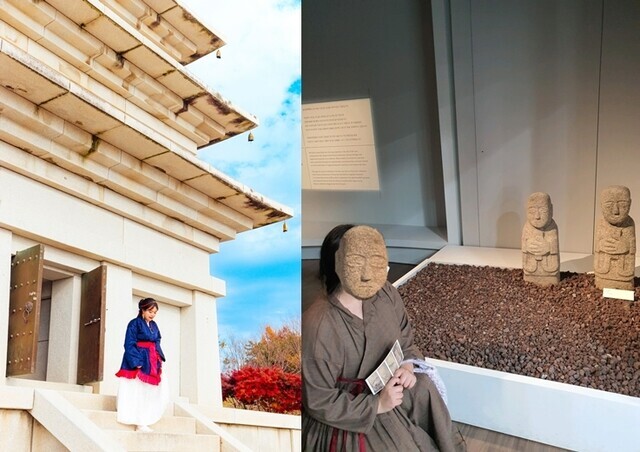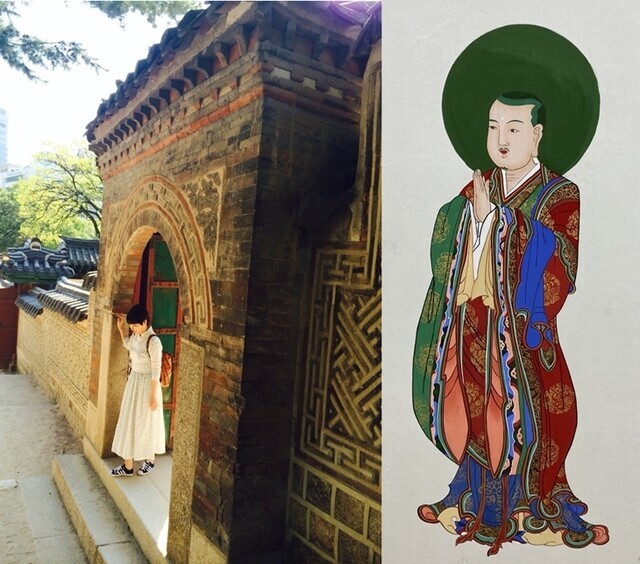hankyoreh
Links to other country sites 다른 나라 사이트 링크
Young Koreans are digging deep into history for their hip fashion throwbacks

For Lee Seon-a, a fun weekend activity consists of dressing up in traditional Korean hanbok clothing and visiting museums and historic sites.
The 26-year-old attended an exhibition at Gwangju National Museum in a dress fashioned to look like a modified version of the cheollik, a jacket worn by officials during the Joseon era. She has also been to visit the Mireuk Temple site in Iksan dressed in a Baekje-era outfit.
Already a fan of historical dramas like “Jewel in the Palace” and “Jang Hee Bin” since her youth, Lee developed a fascination with hanbok a few years back.
She has also made her own hanbok to wear in her everyday life, although the recent proliferation of places selling modified hanbok and accessories — including decorative norigae pendants — means it has become much easier to purchase similar outfits too.
“I’ve seen a lot of places these days selling very sophisticated items based on traditional craft motifs, and you can see a lot more interest in hanbok and traditional culture among younger people online,” she explained.
“In the past, I worried about calling too much attention to myself, but these days I’ve seen more and more people wearing hanbok and taking pictures of each other on trips,” she added.
Over the past few years, more and more young Koreans in their 20s and 30s have been dressing in traditional hanbok and buying items based on traditional cultural themes.
A major factor in this has been the widening selection of outfits and traditional craft-based items that they can easily incorporate into their daily life.
After the practice of wearing hanbok to visit old palaces became a popular pastime, it started to develop into new forms of traditional culture appreciation that include visiting museums and historic sites in hanbok or learning the traditional art of Korean archery.

The most active marketplaces for hanbok and traditional craft-based items have been crowdfunding platforms. Since most of the producers are small-scale operators that have trouble anticipating demand, they typically adopt an approach where they produce and sell items once a certain investment has been raised.
In the first and second halves of last year, the crowdfunding platform Tumblbug held two special expositions on traditional themes. A total of 169 projects were staged, reaching 2.36 billion won in support (sales).
Popular items range from distinctive garments — such as jackets based on a jeogori (hanbok upper garment) motif and a winter coat based on a modified magoja jacket — to items like an umbrella inspired by the dancheong patterns on traditional wood architecture.
Marking its fifth edition last August, the Hanbok Expo drew an all-time high of 74 participating businesses.
Another contributor has been improved accessibility for younger people who enjoy an older style.
“People have often associated ‘tradition’ with something stiff and stuffy, but these days traditional items like the goods they sell at the National Museum of Korea are being seen as kind of hip,” explained 25-year-old Yu Eun-ji, who said she recently purchased a modified hanbok skirt.
“Even when they’re off the rack, they still have a high-end feel to them, and the wide range of items available makes it enjoyable to browse and pick things out,” she added.
Ji Hye-won, a manager at Tumblbug, said, “Hanbok brands had mainly been based in offline stores, but with the pandemic they started selling things online, and they began reaching people in their 20s and 30s.”
“We’re planning to hold another special traditional expo this March, and 62 creators have applied to participate to date,” she added.
As hanbok outfits have gotten people interested in traditional culture, this has led some of them to pursue other, even more special forms of traditional cultural pastimes.
After developing an interest in traditional culture when she started wearing everyday hanbok garments, 34-year-old office worker Kim Ha-young also took up traditional archery and painting Buddhist motifs.
“Firing arrows and drawing lines with my brush have both helped to boost my concentration and relieve stress,” she said.
“With Korean culture enjoying worldwide popularity these days, I’d like to see us preserving older things by redesigning them in ways suited to the contemporary era,” she added.
By Lee Woo-yun, staff reporter
Please direct questions or comments to [english@hani.co.kr]

Editorial・opinion
![[Column] How tragedy pervades weak links in Korean labor [Column] How tragedy pervades weak links in Korean labor](https://flexible.img.hani.co.kr/flexible/normal/500/300/imgdb/original/2024/0703/8717199957128458.jpg) [Column] How tragedy pervades weak links in Korean labor
[Column] How tragedy pervades weak links in Korean labor![[Column] How opposing war became a far-right policy [Column] How opposing war became a far-right policy](https://flexible.img.hani.co.kr/flexible/normal/500/300/imgdb/original/2024/0702/5017199091002075.jpg) [Column] How opposing war became a far-right policy
[Column] How opposing war became a far-right policy- [Editorial] Korea needs to adjust diplomatic course in preparation for a Trump comeback
- [Editorial] Silence won’t save Yoon
- [Column] The miscalculations that started the Korean War mustn’t be repeated
- [Correspondent’s column] China-Europe relations tested once more by EV war
- [Correspondent’s column] Who really created the new ‘axis of evil’?
- [Editorial] Exploiting foreign domestic workers won’t solve Korea’s birth rate problem
- [Column] Kim and Putin’s new world order
- [Editorial] Workplace hazards can be prevented — why weren’t they this time?
Most viewed articles
- 110 days of torture: Korean mental patient’s restraints only removed after death
- 2In the blink of an eye, an unthinkable crash turned a night out into a nightmare
- 3Families, friends mourn loved ones cut down in prime in deadly car crash
- 4[Column] How tragedy pervades weak links in Korean labor
- 5Experts cast doubt on driver’s claim that sudden unintended acceleration caused deadly crash
- 6Democrats seek to impeach 4 prosecutors, including those tied to probes into Lee Jae-myung
- 7KCC chief resigns to avoid impeachment, the second in 7 months
- 8Korea to create dedicated population strategy ministry to combat low birth rate, aging society
- 9More South Koreans, particularly the young, are leaving their religions
- 10Dreams of a better life brought them to Korea — then a tragic fire tore them apart